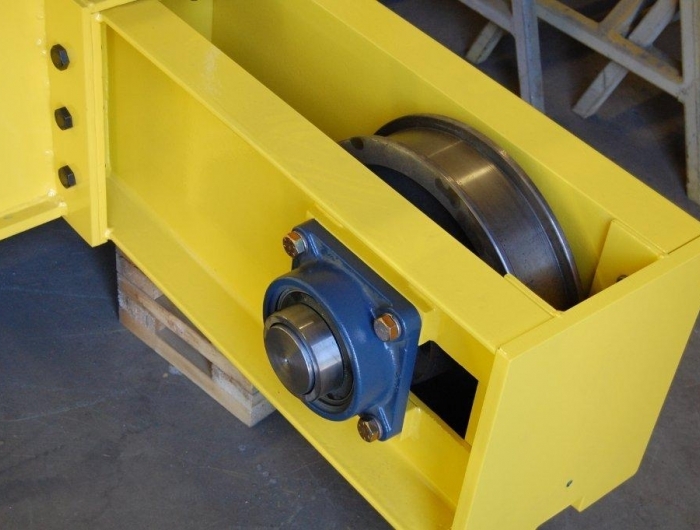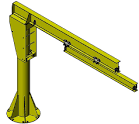Overhead crane wheels play a crucial role in the smooth operation of overhead cranes. These wheels bear the weight of the crane and the load it carries, allowing the crane to move along the rails. To ensure optimal performance and longevity, it is essential to calculate the specifications of the crane wheels accurately. In this article, we will explore the factors that influence the calculation of overhead crane wheel specifications, including material selection, hardness, and heat treatment techniques. We will also discuss the importance of periodic inspections and maintenance to detect premature wear and address potential issues before they cause significant damage.
Factors Influencing Overhead Crane Wheel Specifications
Material Selection
The choice of material for overhead crane wheels is critical to their performance and durability. Various materials, such as alloys, low-carbon steel, and medium-carbon steel, can be used to manufacture crane wheels. Each material has its own hardness potential, with higher carbon content generally resulting in greater hardness.
Medium-carbon steel is commonly employed due to its wide availability and cost-effectiveness. However, advancements in heat treating technology have led to increased hardness in crane wheels made with medium-carbon steel, particularly in the crane wheel tread, where the wheel meets the rail. This hardened tread reduces wear and extends the lifespan of the crane wheels.
On the other hand, the crane wheel flanges should not be hardened to maintain the necessary ductility and prevent breakage.
Heat Treatment Techniques
Heat treating plays a crucial role in enhancing the hardness and toughness of crane wheels. It involves subjecting the wheels to specific heating and cooling processes to alter their microstructure and properties. The depth of hardness in the wheel tread is a critical aspect that should not be neglected.
While surface hardness is relatively easy to measure, the depth of hardness is more challenging to determine accurately. When hardening does not penetrate deep into the wheel tread, the wheel becomes prone to spalling, where metal fragments break off the surface, shortening the wheel’s lifespan. Therefore, it is essential to choose a vendor with expertise in providing consistent deep hardening of the crane wheel tread.
Importance of Periodic Inspections
Crane wheels are often the first parts to show the effects of crane issues, such as misaligned rails. Periodic inspections are crucial in detecting premature wheel wear and providing insights into correcting issues before they cause significant damage. During inspections, it is recommended to measure and document the thickness of wheel flanges to monitor the rate of wear between inspections.
A gradual wear rate over a more extended period may be of less concern, but rapid wear can indicate a serious problem that requires immediate attention. By conducting regular inspections, potential problems can be identified early, minimizing downtime and costly repairs.
Crane Wheel Types and Applications
Single Edge Crane Wheels
Single edge crane wheels are commonly used for the traveling of bridge cranes and gantry cranes. They have a flange height ranging from 20mm to 25mm and are typically made of ZG340-640 cast steel or ZG-50SiMn low alloy steel. The hardening depth of the wheel tread is at least 20mm, with a surface hardness of 300-350HB for ZG340-640 cast steel and 420-480HB for ZG-50SiMn low alloy steel.
Double Edge Crane Wheels
Double edge crane wheels are primarily used for the trolley traveling of bridge and gantry cranes. They have a slightly higher flange height, ranging from 25mm to 30mm. The materials used for double edge crane wheels are similar to those of single edge crane wheels, including ZG340-640 cast steel and ZG-50SiMn low alloy steel. The hardening depth and surface hardness requirements are also the same as those for single edge crane wheels.
Customized Crane Wheels
In addition to standard crane wheel types, customized crane wheels are also available to meet specific design requirements. These custom wheels can be tailored to the unique needs of different applications, ensuring optimal performance and longevity. When opting for customized crane wheels, it is essential to work with a reputable manufacturer who can provide expert guidance and deliver high-quality products that meet your exact specifications.
The Process of Crane Wheel Production
The production of crane wheels involves several essential steps to ensure their quality and performance. The process begins with advanced design and material selection, considering factors such as load capacity, operating conditions, and expected lifespan. Once the design and material specifications are determined, the production process moves on to rough and finish machining.
This step is crucial for achieving the desired dimensions and surface finish of the wheels. After machining, the wheels undergo heat treatment, such as quenching and tempering, to enhance their hardness and toughness. Finally, the finished wheels are inspected for quality assurance before they are ready for installation.
Advantages of Crane Wheels
Crane wheels, especially those manufactured with high-quality materials and advanced production techniques, offer several advantages for overhead crane operations. These advantages include:
- Reduced maintenance costs: High-quality crane wheels can minimize wear and extend the life of the rail, reducing the need for frequent replacements and associated maintenance expenses.
- Increased load carrying capability: Certain types of crane wheels, such as those with flat tread designs, can provide up to 40% additional load carrying capacity compared to other types of wheels, allowing for more efficient and versatile crane operations.
- Improved rail life: By reducing wear and minimizing damage to the rail, high-quality crane wheels contribute to the longevity and reliability of the entire overhead crane system.
- Enhanced safety: Well-maintained crane wheels ensure smooth and stable movement of the crane, promoting a safer working environment for operators and preventing accidents caused by wheel failures or misalignment.
Crane Wheel Stocking Programs
For businesses that require a regular supply of specific crane wheels, developing a stocking program can be highly beneficial. A stocking plan is tailored to the customer’s specific needs, ensuring the availability of the required wheels on a regular basis. This approach helps minimize downtime and emergency situations caused by wheel failures or premature wear.
By working closely with a trusted supplier, businesses can establish a stocking program that optimizes their operations and eliminates potential disruptions.
Reconditioned Crane and Heavy Wheel Assemblies
In addition to new crane wheels, some manufacturers specialize in reconditioning and refurbishing existing wheel and axle sets. This service is particularly useful for businesses looking to extend the lifespan of their crane wheels and reduce overall costs. The reconditioning process involves inspecting and repairing worn or damaged components, restoring them to their original specifications.
By leveraging the expertise of experienced professionals, businesses can maximize the value and performance of their existing wheel assemblies, avoiding the need for complete replacements.
Quality Assurance and Documentation
Ensuring the quality of crane wheels is crucial for their performance and longevity. Reputable manufacturers maintain rigorous quality assurance processes throughout the production and inspection stages. This includes adhering to industry standards for heat treatment, chemistry, and mechanical requirements.
Documentation packages are kept on file for every order, providing customers with access to detailed quality control records. These records can be valuable for auditing purposes and serve as evidence of the high standards maintained by the manufacturer.
Conclusion
The calculation of overhead crane wheel specifications is a critical process that requires careful consideration of various factors such as material selection, heat treatment techniques, and periodic inspections. Accurate calculation and selection of crane wheel specifications can result in improved performance, reduced maintenance costs, and increased safety.
By working with reputable manufacturers and implementing proper maintenance practices, businesses can ensure the longevity and reliability of their overhead crane systems. Regular inspections, periodic maintenance, and timely replacement of worn or damaged crane wheels are essential to mitigate potential issues and maximize the lifespan of these crucial components.




